My long, difficult day of travel from Breb, Romania to Cluj-Napoca began when I hitched a ride with two Romanian-Americans who were making their annual visit to family. They dropped me at the train station in Baia-Mare, where I hoped to score a ticket with my first class Eurail Global Pass. With the exception of scattered chunks of plaster that had fallen off the walls, the circular waiting room was completely empty. I stepped up to the sole clerk standing behind an iron barred window and asked for a ticket to Cluj. My only option was a 3:30 p.m. train that would arrive at 8:30, a five hour ride for a drive that could be made in about 2.5 hours. The clerk muttered “autogare” (bus station) and pointed back the way I had come. I was learning what every Romanian has known for decades: in this part of the world, buses are often a much better option than the inconveniently scheduled trains.
With bus ticket finally in hand, I lugged my suitcase out to the bays to find my coach. Neither the bays nor my ticket were numbered and I saw no bus marquee with my destination, so I began querying everyone in sight by saying “Cluj-Napoca?” Finally, a young woman named Mikhaila, who spoke perfect English, came to my rescue. Since her elderly mother was taking the same bus, she showed me the correct bay and promised to stay around until we were both safely aboard. Curious, her mother asked my age. Mikhaila translated my answer: 61. Her mother’s eyes crinkled at the corners as she beamed and grabbed my hand. Her seat was directly in front of me and we spent the next couple of hours communicating with giggles and sign language. Too soon, she signaled that her stop was coming up. She gathered her things and took a few steps two toward the front of the bus, then turned and walked back to my seat. Leaning down, she planted kisses on both my cheeks and give my hand one last squeeze. She was still waving and blowing kisses as we pulled away.
An hour later the bus pulled up in front of the Cluj train station and I hopped out into 90 degree heat and worse humidity. I was exhausted but still had a mile to walk. Bedraggled and soaked in perspiration, I finally located my hostel, checked in, struggled up two flights of stairs with my luggage, and collapsed on the bed. And that’s where I probably would have stayed until morning…if I hadn’t been so hungry.
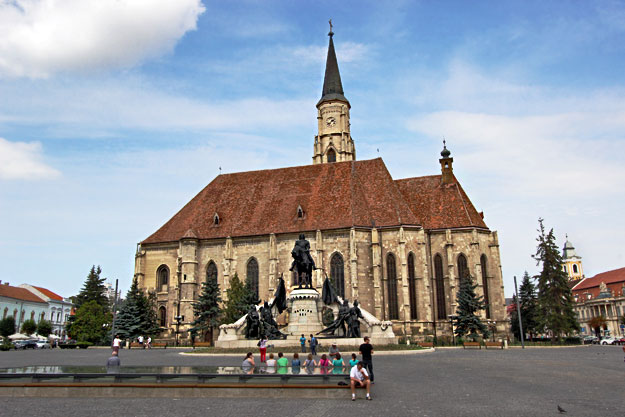
Groaning, I forced myself to shower, change clothes, and go in search of food. I didn’t have to look very far. Three blocks away, just beyond Unirii Square, with its burbling fountains and stately Saint Michael’s Cathedral, I found Boulevard Erolior (Heroes Boulevard), a quasi-pedestrian mall lined with shops and restaurants. The signboard touting gourmet coffee at Olivo Cafe caught my eye and I settled into an overstuffed leather banquette just inside the front door, where I could people-watch as I ate dinner.
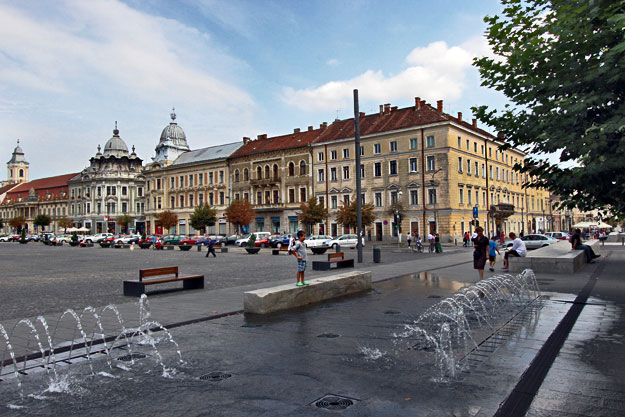

Sidewalk tables filled up as people met for drinks after work. Couples strolled by arm in arm and families pushed baby strollers down the wide Promenade. Everyone seemed relaxed and happy. After a rest and a delicious meal, rather than return to my hostel I decided to explore. Boulevard Erolior led me to Avram Iancu Square, anchored on one end by the Neo-baroque Romanian National Opera and on the other by Dormition of the Theotokos Cathedral, a Romanian Orthodox church with a main dome inspired by the Hagia Sophia in Istanbul and four side towers designed in Romanian Renaissance style.

The square was full of people listening raptly to the deep, rich call and response between cantor and congregation emanating from the church. Serendipitously, I had arrived on August 14th, the eve of The Assumption, which celebrates the body of the Virgin Mary being taken up to Heaven at the end of her earthly life. Known in Orthodoxy as the Dormition of the Theotokos (the falling asleep of the Mother of God), this service is one of the highest holy days in this cathedral of the same name. Tentatively, I wriggled through the crowd in the darkened nave and leaned against the back wall, trying to be as unobtrusive as possible. Somberly dressed men stood on the right-hand side of the nave, while women stood on the left. Before me, a sea of tiny flickering candles, cupped reverently in the hands of worshipers, illuminated careworn faces wreathed in head scarves. One-by-one, parishioners solemnly made their way to the front of the nave to kiss the holy icons. The energy was so palpable that the hair on the back of my neck stood up. I slipped quietly away before the end of the service, surprised to have witnessed such an intense exhibit of devotion.
But it was not the last surprise that was in store for me. To my delight, I learned that Cluj-Napoca, commonly referred to by the locals as Cluj, is a university town, which explained the city’s strong cafe culture. One morning I whiled away a couple of hours at a coffee shop on Unirii Square in the heart of the city; on another afternoon I discovered Insomnia Cafe, the oldest pub in town, where none of the furniture matched and everything was painted in riotous colors.
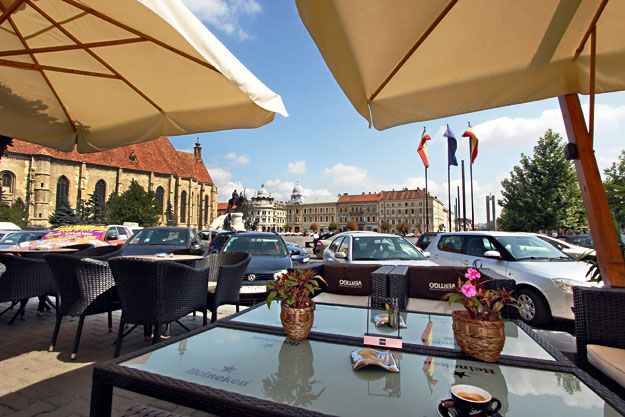

My most delicious meal during my four-day stay was at Ursus Restaurant and Micro-Brewery, located in a restored beer factory on Museum Square, the city’s oldest and most historic square. Homemade brown bread, baked polenta with cheese, and a thick cream of broccoli soup with heavy cream drizzled on top set me back $8. In fact, I never had a bad meal during my four days in Cluj, and no meal cost more than $10.
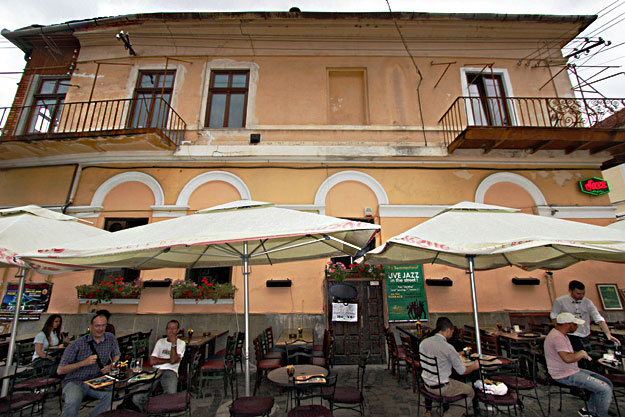
Cluj offered more than just good food and drink. This second largest city in Romania is home to the a botanical garden that features a Japanese garden and a Roman garden built around archeological remains from the Roman colony of Napoca. I spent a pleasant afternoon walking along the Somes River and Simion Barnutiu Central Park, where local Roma boys posed for my camera. The city is surrounded by forests and the Turda Gorges, located to the southeast, are absolutely stunning. Castles like the Bontida Bánffy Castle, sometimes referred to as “the Versailles of Transylvania,” dot the surrounding countryside.
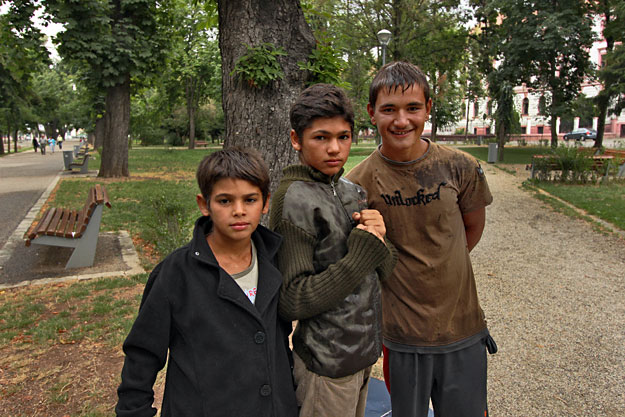
Museum aficionados will find no less than ten institutions to explore, including the Cluj-Napoca Art Museum, housed in the former Baroque-style palace of the count György Bánffy; the National Museum of Transylvanian History; the Ethnographic Museum; the Pharmacy Museum; the Water Museum; museums of Babes-Bolyai University; the Mineralogy Museum; the Museum of Paleontology and Stratigraphy; the Museum of Speleology; and the Zoological Museum. From hot springs to ski resorts, this little-known area of Romania appears to have it all.
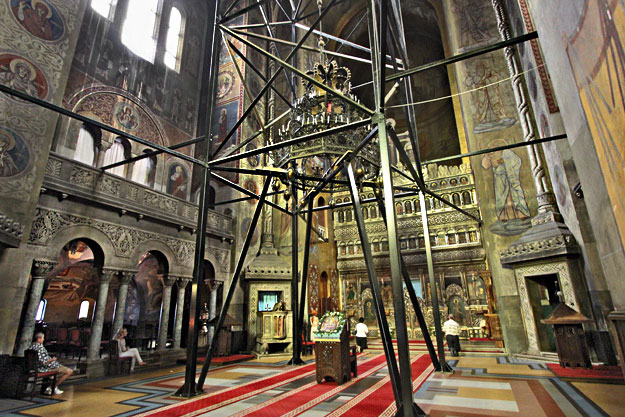
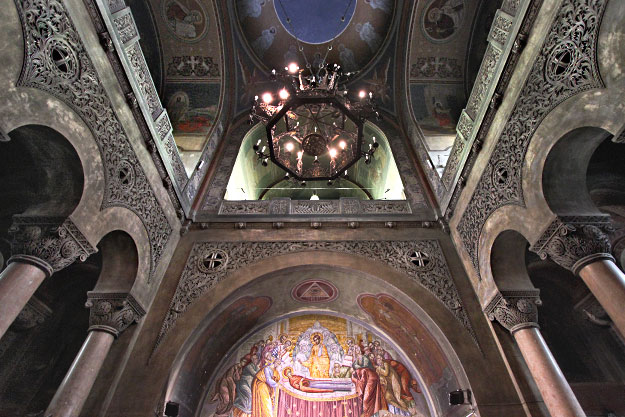
After four days I’d sampled most of what Cluj had to offer, but I couldn’t leave town without a second visit to the Orthodox Cathedral. With so many people attending the Assumption service, I’d seen very little of the interior and I suspected it was magnificent. I was not disappointed. Every square inch of the walls and ceiling are painted with portraits of saints and religious scenes, and the screens that separate the sanctuary from the nave hold scores of gold-framed icons, surrounded by gold filigree embellishments. Shrines on either side of the nave glitter from floor-to-ceiling murals composed of millions of glass mosaic tiles. Brass lined enclaves glow golden with the flames from hundreds of small candles lit in remembrance of loved ones. Above it all hangs an enormous chandelier, so heavy that it has to be braced by an iron framework; even the carpet is a piece of art.

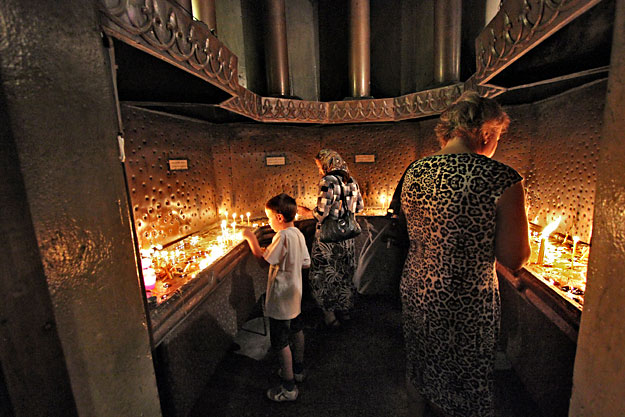
On my final evening in Cluj, I sat down with Raluca (Ralu) Ciobanu, a young woman who recently opened a travel agency in the city. The day before I arrived she’d discovered my Facebook Page and read that I was bound for Cluj. She shot me an excited email, offering to meet up and I was delighted to spend time with a someone who was an expert on the local culture. Over refreshments at the newly opened Boema Pub, I asked why Cluj is not a more popular tourist destination. On average the city receives only 700,000 tourists each year, many of whom stay only one day. She explained that most Romanians earn so little that they cannot travel extensively, and most international travelers are more focused on the well known destinations such as Budapest in Hungary or cities in Romania such as Brasov, which has capitalized on the legend of Dracula, despite the fact that Cluj-Napoca was the historical capital of Transylvania.
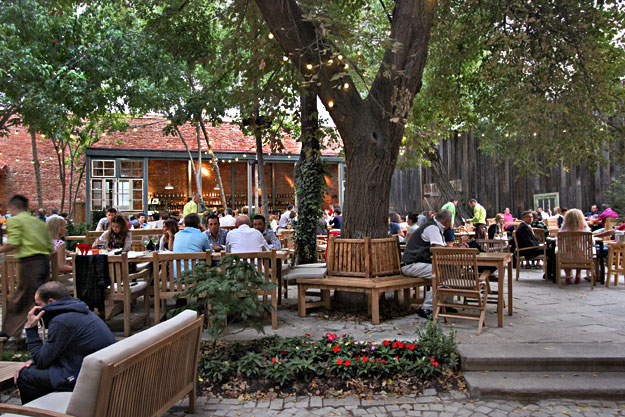

As a new business, to date Ralu has been forced to concentrate on offering tours that are more in demand, but I believe she was infected by my enthusiasm. Her final comment before parting was that she was going to put together and market tours for Cluj-Napoca. I wish her great success, because frankly, Cluj was my favorite destination in all of Romania. It’s a gem in the heart of Transylvania, just waiting to be discovered.

Transylvania is such a beautiful region. I also suggest those who plan to travel to Romania Sibiu or Brasov, also very beautiful cities. You can see some medieval churches, castles and other amazing places, in terms of landscapes and architecture.
Would Cluj be a good place to base a family for 1-2 months to see Trasylvania?
And what was your favorite city/country to live (if you had to choose) in Eastern/Central Europe?
Tom, I think Cluj would be the ideal place; it is centrally located for all destinations in Transylvania. As for my favorite country/city in Eastern Europe, I like Budapest, Hungary, but it’s a very big city. If I had to choose just one I’d say Sofia, Bulgaria. I love Bulgaria for many reasons, among them that everything is very cheap and they are more Mediterranean in view/nature that slavic. The food is fantastic (not so much meat and potatoes and heavy stuff like the other Balkan countries), and the people are so lovely. But keep in mind, I haven;t been to al of Eastern Europe…yet!
Hello, I’m from Cluj as well but I’m currently doing my PhD in Metz in France. If you travel here by any chance, let me know, then I can give you the local tour (perhaps including Luxemburg) and talk more about Cluj or Romania ^_^. Wish you luck in your travels!
What a lovely offer Andrei! I do plan to be in France this year but just for a few days, and only in Paris. But I’ll keep your info and let you know if I’m eve headed your way.
Hi all,
I’m originally from Cluj, I left when I was 12, I’m now 41. I now live in the states. I have traveled to many countries and cities. No city comes close to Cluj when it comes to charm and personality. I took my 3 girls there and they wanted to move to Cluj for ever. The people are very nice, everyone speaks English at restaurants bars, coffe shops and hotels. The dollars is still 1/3 ratio and you can get a lot for ur money.
Cluj is a mini Viena in my opinion. The good thing about traveling to Cluj, you can go to Brasov or the Black Sea in one days car travel and see even more of Romania.
Hi Mario: I can certainly relate with your three girls. I was enchanted by Cluj and its friendly residents. And, as you say, you can’t beat the prices, which are more than affordable for absolutely everything.
I am an American who was privileged to live in Cluj from 1996-2006. My family and I loved living there. It will always be my favorite even though we are back in our own area of the States. Cluj is forever in our hearts. I feel like an Ardelean!
Hi Dan: Thanks for sharing that. Good to know that there are others who are as taken with Cluj as I was!
Being from Cluj and living in Canada, I am glad that there are people like you who discover the true beauty of our country and cities, and not the ugly that a lot of people hear or know about… Glad you enjoyed Cluj 🙂
Thanks Dan – I love finding places like Cluj that aren’t on the travel radar and exposing them to the world.
Rumania a wonderful country in Europe. Every year I go there to meet with my elder sister. My kids like to travel there.
H Sanju: I think I could spend years nosing around Hungaria, Romania, and Bulgaria, and still not see everything!
I would definitely love to get to Romania one of these days, sounds like an amazing country. Though I’ve never heard of Cluj, you’ve put it on my radar now. Glad to hear you liked it so much!
Hi Ali: I’d love to go back to Cluj in the shoulder season when the Universities are back in session – bet I’d like it even more.
You have great photos and I like the masai one as its close home. Great article on Romania.
Thanks Robert. I hope to get back to Africa someday, as I’ve barely scratched the surface (only been to 6 African countries).
Hey Barbara,
Nice post.After reading your travel story, now Romania is in my wish list.
Hi Celina: So glad you enjoyed it. If you’re like me, my list is getting longer rather than shorter. 🙂
Thank you, Barbara, for your wonderful story about your adventures in Cluj. Please, return to beautiful Romania so you can share other Romanian adventures with us. Visit http://www.rocherichard.com to read some more tales about Transylvania. I am not selling any tourist services. I am just encouraging people to visit Romania anytime April through October. Romania is a wonderful country worth visiting many times.
You are most welcome, Richard. I know there is a lot of Romania I haven’t seen, but that’s just a good reason to come back!
I want to go to Romania, but it seems I’ll have to do it in the summertime…I’m afraid the other times of year would be too cold. I will definitely go to Cluj when I go. Love your story!
Hi Corinne: Glad I was able to introduce you to a place you hadn’t heard of. I’m sure you won’t be disappointed.
Great photos as usual. I got to visit Romania in 2011 and loved Transylvania much more than Bucharest. The little town of Sinaia has a wonderful castle and mountaintop restaurant with interesting architecture and homes.
Hi Rashad: Thanks so much. I agree about Sinaia; I was there during a day trip and SO wished I’d chosen to stay there rather than in Brasov!
I’m from Sinaia and I’m very happy to heard that you enjoy this little town. I love very much Cluj, which is a special city.
Barbara, thank you very much for the beautiful words about our country, Romania.
It is a wonderful city, Camelia. I’d love to return one day and spend more time there.
Hi! Welcome to Romania! 🙂
Thanks Muza-chan.
I’m enjoying your adventures now more than ever, because you seem to be including more photos than you used to use.
Thanks for sharing that, Tom. I sometimes worry that I’m depending on photos too much; that my words should be able to paint the picture. But we’re lazy creatures, all of us, and I know many people just scroll through and look at the photos. I really appreciate that you take time to read my words.
Dear Barbara, I really enjoyed your report about the wonderful town now called Cluj-Napoca, however you do not mention that this was several hundred years the treasure of Kolozsvár main city of hungarian speaking Transylvania.You do not mention the wonderful gothis catholic church of St.Michael built in the 14th century, do not mention the famous Házsongárd cemetery also from the medieval times and almost worth like Pere-Lachaise cemetery in Paris. The orthodox cathedral was built between 1923 and 1933, after the Union of Transylvania with the Romanian Old Kingdom.
I sicerely hope you know and visited all the hungarian sites in this wonderful city.
Barbara, thank you very much for sharing the experience you had here, in our lovely Cluj! You must see the I Love Cluj Facebook Page and the new website: ilovecluj.ro – on both of these you will find great pictures of Cluj-Napoca for the time you will miss it 🙂 here’s the FB Page: https://www.facebook.com/ILoveCluj
All the best and come back soon!
Hi Stefania: I’ve been to the website and Facebook Page. Thanks so much for sharing those links. Hope I can come back for a longer stay someday.
Sounds like Cluj was an amazing experience! I’ve always wanted to see a cathedral or a castle, but I’ll just have to wait until I have enough money! Thanks for sharing your trip with us!
You’re welcome Michelle. Hope you get to hit the road someday, too. And keep in mind that with hostels, you don’t need a lot of money to travel.
I adored Cluj, and Romania, when I was there for a couple of weeks earlier this year. It has such a laidback vibe, although I had a different weather experience – rain and ferocious hail, in July! Romania is such a hugely underrated country, and one that receives an unfairly disproportionate amount of bad press.
Hi Tom: I also heard the negatives but never experienced them. Eastern Europe, in general, has much to offer, and Cluj-Naoca was near the top of my list of favorite cities.
The first part of your journey reminds me of Paul Theroux expression: “Travel is only glamourous in retrospect” but you found much to recommend it once you got to this town that I’ve never heard of. Well done for getting so off the beaten track of Europe.
Thanks Mark. These days it’s harder and harder to find out-of-the-way places that haven’t been negatively impacted by tourism. It’s not always easy to get to them, but almost always worth the effort.
What an amazing experience. I have never made it to Romania, but it’s as beautiful and charming as Prague and Warsaw. I love the architecture and churches, so amazing. I’m also a big fan of coffee so Insomnia Cafe is going to be on my list of things to do and visit :).
Hi Agness- if you do make it to Cluj, you’ll love Insomnia. Really quirky and fun, with super fast, free wifi
Barbara, I really enjoyed reading about Cluj-Napoca, especially about the friendliness of the people and the wonderful food. It’s often the things and events we stumble upon, (not the things that we planned) like the ceremony for the Feast of the Assumption, that make a visit so memorable. I’ll definitely look at the Musai Travel website, thanks for sharing.
Hello Mary, I’m sure you would love it here :). At the time I met Barbara we didn’t have our incoming english website ready, and it’s only going to be done by the end of this year.